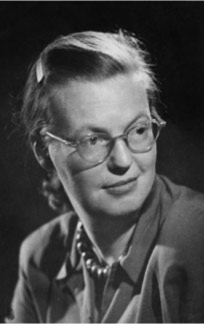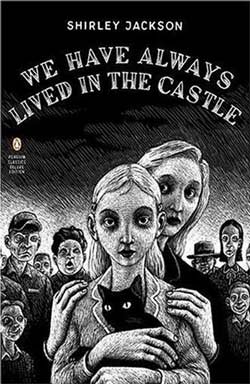
The story was published during a time when many town governments across America sponsored weekly cash-prize lotteries as a means of bringing people into town from the surrounding farms to stimulate the postwar economy for the local merchants. The name of the story was, of course, “The Lottery” by Shirley Jackson. You may read (or more likely re-read) it here.
Many high school students (and I was one) suffered through a great deal of moaning and gnashing of teeth trying to eke out the symbolism underlying a story that described the seemingly ordinary day, which was a celebration of sorts of an annual occurrence in that small village of less than three hundred people. It is only in the final paragraphs that the reader realizes what is happening. What does the premise say about our society? What does it say about human nature?
Born in 1919, Shirley Jackson attended Syracuse University where she met and married author and literary critic, Stanley Edgar Hyman. In the early years of her marriage, Jackson found little time to write but eventually began to publish short stories, one of her earliest and best known stories, “Come Dance With Me in Ireland,” also published in The New Yorker, was included in the collection Best American Stories:1944. Although that story focused on the crude lack of kindness that invades human interaction, it lacked the terror found in much of her later work.

Perhaps the most well known and well remembered of Jackson’s novels is We Have Always Lived in the Castle published in 1962, just three years before her death. In this novel, the gothic theme of how people treat those who are perceived to be “different” is palpable, as is the theme of the limits of female self-determination in society at that time. The fact that four family members have been poisoned before the book opens is always in the background but is clearly related to the present torment by the remaining family members at the hands of the villagers. Jackson does not allow any excuse for such vile behavior by the villagers. The entire book is both riveting and haunting.
Obsessed as Jackson was with person to person evil, nearly everything that she wrote had a crime component. She was nominated for the Mystery Writers of America Edgar Allan Poe Award for “Louisa, Please Come Home” in 1961 and she won the Edgar in 1966 for “The Possibility of Evil”—two short stories, both of which show two very different ways in which private loneliness influences the actions of the main character.
If you have never read anything by Shirley Jackson, other than perhaps a high school reading of “The Lottery,” I suggest you take the time to do so, slowly and carefully. Her work has survived the decades.
Terrie Farley Moran’s recent collection of short stories, THE AWARENESS and other deadly tales, is currently available in e-format for the Nook and the Kindle. Terrie blogs at Women of Mystery and her short story “Fontaine House” can be read in the August 2012 issue of Ellery Queen Mystery Magazine.
Read all posts by Terrie Farley Moran for Criminal Element.

I did read The Lottery in school – just like you Terrie. I remember it to this day. It made such an impression. I didn’t remember who had written it and I have never sought out her other work. Now I will. Great post!
Good post, and thanks for bringing her up. I think “The Possibility of Evil” is one of the best crime short stories I have ever read. The double-meaning last sentence is a real punch in the gut. And in the age of cyberbullying I think this story might resonate more with high schoolers than “The Lottery.”
Thanks, Deb.
Rob, I’m so glad you enjoyed this, and I’ll have to re-read “the Possibility of Evil” with my eye on the last line.
Rob, I must be getting senile. For some reason I thought there was another paragraph after that memorable line. I thought she looked out the window, but of course that is what I saw her doing in my mind.
Also her novel “The Haunting of Hill House,” which I think is even creepier than the others. And in another genre two really funny books about family life: “Life Among the Savages” and “Raising Demons.” All are worth the trouble to find them.
Oh, Cathy, you are so right. I had completely forgotten her Jean Kerr-like books about raising her kids. A very popular sub-genre back in the day. And the two you mention are gems.
The Haunting of Hill House is very creepy, and when it comes to Shirley Jackson’s work, the creepiness is always stunning.